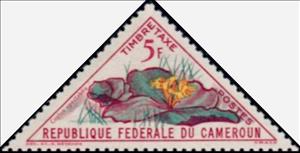Stamp: Costus spectabilis (Cameroun 1963)
Costus spectabilis (Cameroun 1963)
10 April (Cameroun ) within release Flowers goes into circulation Stamp Costus spectabilis face value 5 Central African CFA franc
| Stamp Costus spectabilis in catalogues | |
|---|---|
| Michel: | Mi:CM P43 |
| Stamp Number: | Sn:CM J42 |
| Yvert et Tellier: | Yt:CM T43 |
Stamp is square format.
Also in the issue Flowers:
- Stamp - Hibiscus rosa-sinensis face value 0.50;
- Stamp - Erythrina sp. face value 0.50;
- Stamp - Plumeria lutea face value 1;
- Stamp - Ipomoea face value 1;
- Stamp - Hoodia gordonii face value 1.50;
- Stamp - Crinum face value 1.50;
- Stamp - Ochna face value 2;
- Stamp - Gloriosa face value 2;
- Stamp - Costus spectabilis face value 5;
- Stamp - Bougainvillea spectabilis face value 5;
- Stamp - Delonix regia face value 10;
- Stamp - Haemanthus face value 10;
- Stamp - Ophthalmophyllum face value 20;
- Stamp - Titanopsis face value 20;
- Stamp - Amorphophallus face value 40;
- Stamp - Zingiberacee face value 40;
- Se-tenant - Hibiscus, Erythrina sp. face value 2*0.50;
- Se-tenant - Hoodia gordonii, crinum face value 2*1.50;
- Se-tenant - Costus /Bougainvillea face value 2*5;
- Se-tenant - Plumeria, Ipomoea sp. face value 2*1;
- Se-tenant - Gloriosa, Ochna face value 2*2;
- Se-tenant - Amorphophallus / Zingiberacee face value 2*40;
- Se-tenant - Ophthalmophyllum / Titanopsis face value 2*20;
Stamp Costus spectabilis it reflects the thematic directions:
A flower, sometimes known as a bloom or blossom, is the reproductive structure found in plants that are floral (plants of the division Magnoliophyta, also called angiosperms). The biological function of a flower is to effect reproduction, usually by providing a mechanism for the union of sperm with eggs. Flowers may facilitate outcrossing (fusion of sperm and eggs from different individuals in a population) or allow selfing (fusion of sperm and egg from the same flower). Some flowers produce diaspores without fertilization (parthenocarpy). Flowers contain sporangia and are the site where gametophytes develop. Many flowers have evolved to be attractive to animals, so as to cause them to be vectors for the transfer of pollen. After fertilization, the ovary of the flower develops into fruit containing seeds. In addition to facilitating the reproduction of flowering plants, flowers have long been admired and used by humans to beautify their environment, and also as objects of romance, ritual, religion, medicine and as a source of food.
Flora is the plant life occurring in a particular region or time, generally the naturally occurring or indigenous—native plant life. The corresponding term for animal life is fauna. Flora, fauna and other forms of life such as fungi are collectively referred to as biota. Sometimes bacteria and fungi are also referred to as flora, as in the terms gut flora or skin flora.
The Kionga Triangle (German: Kionga-Dreieck, Portuguese: Triângulo de Quionga) was a small region of German East Africa situated at the mouth of the Ruvuma River. The Ruvuma served as the border between the German colony and Portuguese Mozambique, and the Kionga Triangle was the only section of German East Africa south of the river. Its principal settlement was Kionga (now Quionga ) which had a population of 4,000 in 1910. It became a German possession in 1894 but came under Portuguese control in April 1916 during World War I. The post-war Treaty of Versailles reaffirmed that the river was the border between Tanganyika, then under British control, and Portuguese Mozambique. The triangle was the only territory that the treaty awarded to Portugal.


